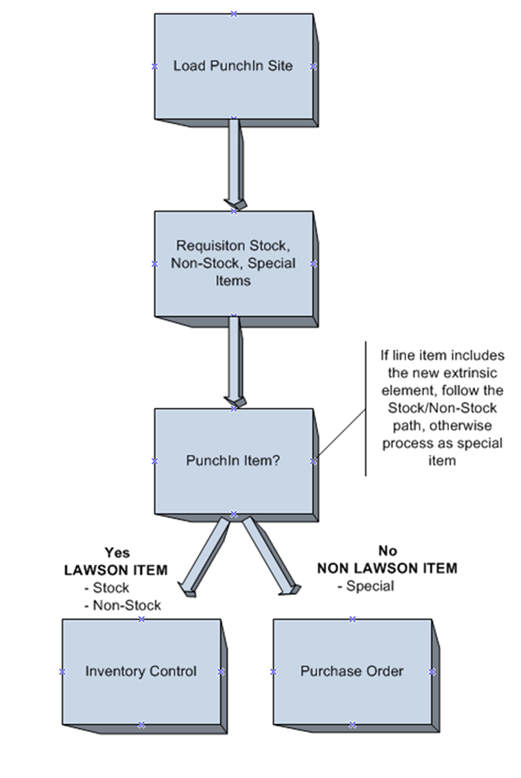PunchIn implementation
Implementing PunchIn requires you to collaborate and work closely with at least one Punchout-enabled vendor who is willing to store, retrieve, and maintain, at a minimum, a list of your company’s Lawson item identifiers and return it to you in the <SupplerPartID> element in the PunchOutOrderMessage. In a standard PunchOut process, the value the vendor places in the <SupplerPartID> element will not be your item identifier, but the vendor’s or supplier's item identifier.
If the PunchOut-enabled vendor cannot put your item identifier into the <SupplierPartID> element, then an Extrinsic element is used instead. In this case, you and the vendor must agree upon the value of the name attribute for you to construct the appropriate <mapping> instruction in the RQC configuration file. More details on <mapping> instructions are found later in this document.
Alternatively, your organization can construct a website containing items from your own Item Master. This website must conform to the best practices outlined for PunchOut websites found in the cXML.org website. Remember, PunchIn is essentially standard cXML Punchout with a flag in the document. This document directs the Lawson Procurement Punchout to process the data contained in the received PunchOutOrderMessage, as if it came from your local Item Master, as an I-nventory, S-tock or N-on stock-item type. By design, a true Lawson Procurement PunchOut assumes that all items are X-type or Special items. This requires time for you and your business partner to plan, discuss, implement, and test..
When the user punches out to a PunchOut-enabled vendor (or your company's own PunchIn website) using Requisition Center (RQC) and Lawson Procurement PunchOut, the items returned are evaluated to determine if these are intended to be found in the Lawson Item Master or not (PunchIn vs. PunchOut items). To make this happen, these conditions must be true:
-
The website must conform to the best practices' outline for cXML Punchout sites. The Lawson user or requester must be able to punchout to this website.
-
Any Lawson items intended to be treated as PunchIn items returned from PunchOut must contain the XML element with: <Extrinsic name="PunchInVendor">true</Extrinsic> at the line-level of the PunchOutOrderMessage document. This indicates to Requisition Center that the item should not be treated as X-type items, that is, as a Stock, Non-stock, or Inventory item. See the cXML.org documentation for more information about these data structures.
-
It is the presence of <Extrinsic name="PunchInVendor">true</Extrinsic> that determines the path that the processing logic takes, if it is a normal, default PunchOut processing wherein all items treated as X-type items or a PunchIn processing. No "PunchInVendor" <Extrinsic> element present == default, x-type processing.
-
To make PunchIn work as expected, if the item is a PunchIn item, then the item identifier returned from the Punchout site must be found in your Item Master.
-
The Lawson Requisition Center application then processes the PunchIn item and subject it to the edits one normally expects while operating on Stock/Non-stock item types and default the necessary information from Lawson (the same way RQC behaves with S- and N- type items today).
-
Normal PunchOut will still work as it does now. All PunchOut items are considered X-type (special) item by default.
You (the customer) and your business partner(s) are responsible for identifying and maintaining the data on the "PunchIn" web site. Lawson provides no tools for this task. Discuss the creation and maintenance of the data set with your business partner(s).
If the item identifier data received by Lawson’s requisitioning product is not found in ITEMMAST, the Lawson requisitioning application cannot save or process the requisition. The operator must delete the failed requisition and correct the data before trying again.
